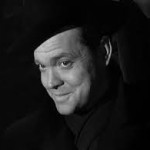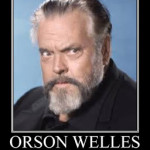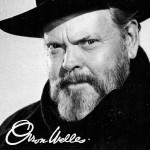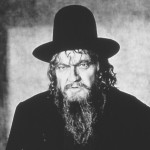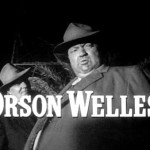I’ve reviewed a few movies starring George Orson Welles (biography here), and watched a number more too. You’ll find some on these pages: Citizen Kane of course, then The Third Man, A Touch of Evil and even his cameo in Catch-22. He made plenty more movies as actor, director and writer, though his battles with studios and others (eg. William Randoph Hearst) mean that his genius remained unfulfilled – had he continued to innovate at the rate he started, movies would never be the same again.
When he was given licence the results were often spectacular, innovative and remain to this day quite the most extraordinary cinema of the past century. But for the last 20 year of his career, Welles appeared in an increasing number of cameos in increasingly awful movies, not to mention sherry adverts, simply for the pay cheque. Doubtless these were lazy performances in bad films, but by that time Welles couldn’t be bothered to fight any more against the system.
To my mind this is a tragic waste of the greatest talent the industry ever saw, but gave rise to a good gag on Spitting Image, whereby the Welles puppet described himself as such a genius that he lived his career backwards, starting with his masterpiece. As Welles himself put it:
“I started at the top and worked my way down.”
Put another way, he was a big man with a big ego and a well-honed talent for self-publicity, but at his peak he could back it up with the end product like few others.
It’s an easy truism to describe this man as a genius, but deserves a more complete analysis of why I personally regard him as a genius and more remarkable that any other actor within my lifetime – and this before I get around to his directing and writing talents.
In his youth he was stocky (compared to the outright obesity of later years), but his screen idol good looks were undeniable. The wonderful thing about acting is that screen presence and charisma don’t demand physical beauty so much as a magnetic flair. As an actor Welles was a natural; he had presence in spades. It doesn’t matter what the movie is, you can’t take your eyes off him.
The more iconic the role, the more Welles rose to the challenge. Taking Harry Lime in The Third Man, Welles doesn’t make so much as one appearance until half way through the screen time, yet he has dominated proceedings from the start. When he does appear from the shadows in a doorway in a broken postwar Vienna, the slight smirk on his lips brought into sharp relief by the glorious contrast of the black-and-white cinematography, the moment is unforgettable, stamped indelibly on your brain for ever.
That is screen presence, long before a word is spoken, the mark of a true star, though used wisely every look and micro-motion applies significance, and in that respect Welles was a master. No accident either. See Citizen Kane and Kane is the focus, not just by what he says but in every aspect of his behaviour. Next to Hank Quinlan in A Touch of Evil, Charlton Heston almost pales into insignificance.
That alone is a rare gift, though it has to be tempered to achieve maximum effect since the role of any actor is not to use his or her vast ego to dominate screen time but to convince the audience to suspend disbelief. No doubt Welles did have an ego to match, but like all the best actors he was generous and brought out the best out of most of his co-stars – except those not able to keep up with the pace.
Welles had the ability to do that, something gained during his days of leading his rep company ensemble at the Mercury Theatre, leading to radio productions which included the legendary adaptation of War of the Worlds, which induced widespread panic when many listeners took to be a real alien invasion. Such a company is only as strong as the weakest link, but Welles and his partner John Houseman built a talented and loyal troupe, including long-time collaborators Joseph Cotten and Agnes Moorehead (later Endora in Bewitched.) Cotten, Moorehead and other actors made the transition with Welles to Hollywood and greater success. Both appeared in Welles’s masterpieces Citizen Kane and The Magnificent Ambersons; Cotten later co-starred with Welles in The Third Man.
As an actor, Welles had the perfect delivery. His voice, deep, booming and gravelly, but he made every word count. More than that, he was quick of thought and surprisingly light of step (if you take the sewer chase scene in The Third Man as an example.) If you’ve seen that movie, you’ll also remember the scene where Martins confronts Lime in a car on the Wiener Riesenrad at Prater Park, Vienna. When they step off the big wheel, Welles makes the most famous speech in the movie. This is the Wikipedia version:
In a famous scene, Lime meets with Martins on the Wiener Riesenrad, the large Ferris wheel in the Prater amusement park. Looking down on the people below from his vantage point, Lime compares them to dots, and says that it would be insignificant if one of them or a few of them “stopped moving, forever”. Back on the ground, he notes:
- “You know what the fellow said – in Italy, for thirty years under the Borgias, they had warfare, terror, murder and bloodshed, but they produced Michelangelo, Leonardo da Vinci and the Renaissance. In Switzerland, they had brotherly love, they had five hundred years of democracy and peace – and what did that produce? The cuckoo clock.”
This remark was added by Welles – in the published script, it is in a footnote. Greene wrote in a letter “What happened was that during the shooting of The Third Man it was found necessary for the timing to insert another sentence.” Welles apparently said the lines came from “an old Hungarian play”; the painter Whistler, in a lecture on art from 1885 (published in Mr Whistler’s ‘Ten O’Clock’ [1888]), had said, “The Swiss in their mountains … What more worthy people! … yet, the perverse and scornful [goddess, Art] will have none of it, and the sons of patriots are left with the clock that turns the mill, and the sudden cuckoo, with difficulty restrained in its box! For this was Tell a hero! For this did Gessler die!” In This is Orson Welles (1993), Welles is quoted as saying “When the picture came out, the Swiss very nicely pointed out to me that they’ve never made any cuckoo clocks”, as the clocks are in fact German, native to the Black Forest. Writer John McPhee also points out that during the period of time the Borgia flourished in Italy, Switzerland was “the most powerful and feared military force in Europe”, and not the peacefully neutral country that it is currently.
Nonetheless, it was the most pointed line and has always been remembered. As a writer Welles always had an instinct for the memorable line, and as an actor this trait helped him improvise memorable lines too.
To describe Welles as a director, I can do no better to copy Wikipedia’s article on the bold innovations Welles introduced in Citizen Kane, a movie he made at the age of 25 and which still comes out at the top of the ratings for the greatest movie ever made – noting that the innovator is not necessarily the person inventing an idea but the one exploiting it to the full:
Orson Welles said that his preparation before making Citizen Kane was to watch John Ford‘s Stagecoach 40 times. “A lot of people ought to study Stagecoach,” Welles told Peter Bogdanovich. “I wanted to learn how to make movies, and that’s such a classically perfect one — don’t you think so?”
As it turned out, the first day I ever walked onto a set was my first day as a director. I’d learned whatever I knew in the projection room — from Ford. After dinner every night for about a month, I’d run Stagecoach, often with some different technician or department head from the studio, and ask questions. “How was this done?” “Why was this done?” It was like going to school.
Cinematography
Film scholars and historians view Citizen Kane as Welles’s attempt to create a new style of filmmaking by studying various forms of film making, and combining them all into one. However, in an interview in March 1960 with the BBC’s Huw Wheldon, Welles stated that his love for cinema began only when he started the work on Citizen Kane, and when asked where he got the confidence from as a first-time director to direct a film so radically different from contemporary cinema, he responded, “[From] ignorance … sheer ignorance. There is no confidence to equal it. It’s only when you know something about a profession that you are timid or careful.”
The most innovative technical aspect of Citizen Kane is the extended use of deep focus. In nearly every scene in the film, the foreground, background and everything in between are all in sharp focus. This was done by cinematographer Gregg Toland through his experimentation with lenses and lighting. Toland described the achievement, made possible by the sensitivity of modern speed film, in an article for Theatre Artsmagazine:
New developments in the science of motion picture photography are not abundant at this advanced stage of the game but periodically one is perfected to make this a greater art. Of these I am in an excellent position to discuss what is termed “Pan-focus”, as I have been active for two years in its development and used it for the first time in Citizen Kane. Through its use, it is possible to photograph action from a range of eighteen inches from the camera lens to over two hundred feet away, with extreme foreground and background figures and action both recorded in sharp relief. Hitherto, the camera had to be focused either for a close or a distant shot, all efforts to encompass both at the same time resulting in one or the other being out of focus. This handicap necessitated the breaking up of a scene into long and short angles, with much consequent loss of realism. With pan-focus, the camera, like the human eye, sees an entire panorama at once, with everything clear and lifelike.
Any time deep focus was impossible – for example in the scene when Kane finishes a bad review of Alexander’s opera while at the same time firing the person who started the review – an optical printer was used to make the whole screen appear in focus (visually layering one piece of film onto another). However, some apparently deep-focus shots were the result of in-camera effects, as in the famous example of the scene where Kane breaks into Susan Alexander’s room after her suicide attempt. In the background, Kane and another man break into the room, while simultaneously the medicine bottle and a glass with a spoon in it are in closeup in the foreground. The shot was an in-camera matte shot. The foreground was shot first, with the background dark. Then the background was lit, the foreground darkened, the film rewound, and the scene re-shot with the background action.
Another unorthodox method used in the film was the way low-angle shots were used to display a point of view facing upwards, thus allowing ceilings to be shown in the background of several scenes.[75] Since films were primarily filmed on sound stages and not on location during the era of the Hollywood studio system, it was impossible to film at an angle that showed ceilings because the stages had none. In some instances, Welles’s crew used muslin draped above the set to produce the illusion of a regular room with a ceiling, while the boom microphones were hidden above the cloth and even dug a trench into the floor to allow the low-angle shot to be used in the scene where Kane meets Leland after his election loss.
Toland had approached Welles in 1940 to work on Citizen Kane. Welles’s reputation for experimentation in the theatre appealed to Toland and he found a sympathetic partner to “test and prove several ideas generally being accepted as radical in Hollywood”. Welles credited Toland on the same card as himself. “It’s impossible to say how much I owe to Gregg. He was superb,” Welles said.
Storytelling techniques
Citizen Kane eschews the traditional linear, chronological narrative and tells Kane’s story entirely in flashback using different points of view, many of them from Kane’s aged and forgetful associates, the cinematic equivalent of the unreliable narrator in literature. Welles also dispenses with the idea of a single storyteller and uses multiple narrators to recount Kane’s life. The use of multiple narrators was unheard of in Hollywood films. Each narrator recounts a different part of Kane’s life, with each story partly overlapping. The film depicts Kane as an enigma, a complicated man who, in the end, leaves viewers with more questions than answers as to his character, such as the newsreel footage where he is attacked for being both a communist and a fascist. The technique of using flashbacks had been used in earlier films such as Wuthering Heights in 1939 and The Power and the Glory in 1933 but no film was so immersed in this technique as Citizen Kane. The use of the reporter Thompson acts as a surrogate for the audience, questioning Kane’s associates and piecing together his life.
One of the narrative voices is the News on the March segment. Its stilted dialogue and portentous voiceover is a parody of The March of Time newsreel series which itself references an earlier newsreel which showed the 85-year old arms czar Sir Basil Zaharoff getting wheeled to his train. Welles had earlier provided voiceovers for the March of Time radio show. Citizen Kane makes extensive use of stock footage to create the newsreel.
One of the story-telling techniques used in Citizen Kane was the use of montage to collapse time and space, using an episodic sequence on the same set while the characters changed costume and make-up between cuts so that the scene following each cut would look as if it took place in the same location, but at a time long after the previous cut. In the breakfast montage, Welles chronicles the breakdown of Kane’s first marriage in five vignettes that condense 16 years of story time into two minutes of screen time. Welles said that the idea for the breakfast scene “was stolen from The Long Christmas Dinner of Thornton Wilder … a one-act play, which is a long Christmas dinner that takes you through something like 60 years of a family’s life.”
Special effects
Welles also pioneered several visual effects in order to cheaply shoot things like crowd scenes and large interior spaces. For example, the scene where the camera in the opera house rises dramatically to the rafters to show the workmen showing a lack of appreciation for Susan Alexander Kane’s performance was shot by a camera craning upwards over the performance scene, then a curtain wipe to a miniature of the upper regions of the house, and then another curtain wipe matching it again with the scene of the workmen. Other scenes effectively employed miniatures to make the film look much more expensive than it truly was, such as various shots of Xanadu. A loud, full-screen closeup of a typewriter typing a single word (“weak”), magnifies the review for the Chicago Inquirer.
Makeup
The make-up artist Maurice Seiderman created the make-up for the film. RKO wanted the young Kane to look handsome and dashing, and Seiderman transformed the overweight Welles, beginning with his nose, which Welles always disliked. For the old Kane, Seiderman created a red plastic compound which he applied to Welles, allowing the wrinkles to move naturally. Kane’s mustache was made of several hair tufts. Transforming Welles into the old Kane required six to seven hours, meaning he had to start at two in the morning to begin filming at nine. He would hold conferences while sitting in the make-up chair; sometimes working 16 hours a day. Even breaking a leg during filming could not stop him from directing around the clock, and he quickly returned to acting, using a steel leg brace.
Soundtrack
“Before Kane, nobody in Hollywood knew how to set music properly in movies,” wrote filmmaker François Truffaut in a 1967 essay. “Kane was the first, in fact the only, great film that uses radio techniques.”
Behind each scene, there is a resonance which gives it its color: the rain on the windows of the cabaret, “El Rancho,” when the investigator goes to visit the down-and-out female singer who can only “work” Atlantic City; the echoes in the marble-lined Thatcher library; the overlapping voices whenever there are several characters. A lot of filmmakers know enough to follow Auguste Renoir’s advice to fill the eyes with images at all costs, but only Orson Welles understood that the sound track had to be filled in the same way.
In addition to expanding on the potential of sound as a creator of moods and emotions, Welles pioneered a new aural technique, known as the “lightning-mix”. Welles used this technique to link complex montage sequences via a series of related sounds or phrases. In offering a continuous sound track, Welles was able to join what would otherwise be extremely rough cuts together into a smooth narrative. For example, the audience witnesses Kane grow from a child into a young man in just two shots. As Kane’s guardian hands him his sled, Kane begrudgingly wishes him a “Merry Christmas”. Suddenly we are taken to a shot of his guardian fifteen years later, only to have the phrase completed for us: “and a Happy New Year”. In this case, the continuity of the soundtrack, not the image, is what makes for a seamless narrative structure.
Welles also carried over techniques from radio not yet popular in films (though they would become staples). Using a number of voices, each saying a sentence or sometimes merely a fragment of a sentence, and splicing the dialogue together in quick succession, the result gave the impression of a whole town talking – and, equally important, what the town was talking about. Welles also favored the overlapping of dialogue, considering it more realistic than the stage and film tradition of characters not stepping on each other’s sentences. He also pioneered the technique of putting the audio ahead of the visual in scene transitions (a J-cut); as a scene would come to a close, the audio would transition to the next scene before the visuals did.
This is but one example of the art of Welles, though sadly there are few that will ever achieve the level of artistic control over such a project, and therefore produce a result so free from compromise. In a sense you can understand why no artist can be trusted by studio execs whose main – only – game is to make money, but the results are inevitably flawed when you depend on a test audience to decide the direction and the vision of the originator is clouded.
You wonder what Welles might have made had he been given free reign and finance nowadays, but I know for a fact it would be grabbing the headlines and almost certainly awards. There will never be another like him.


